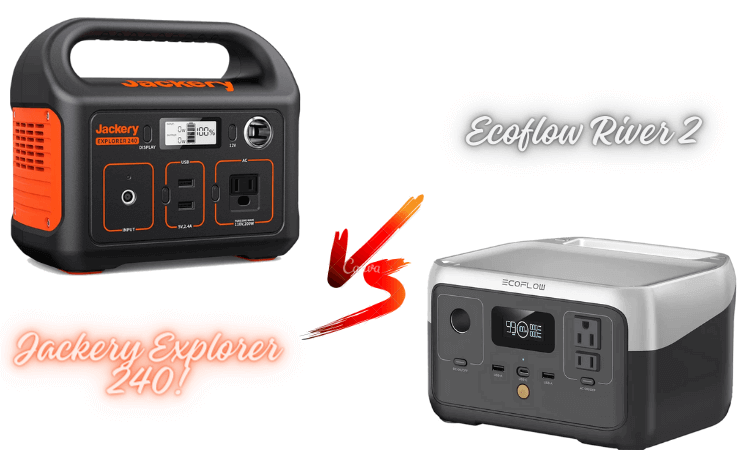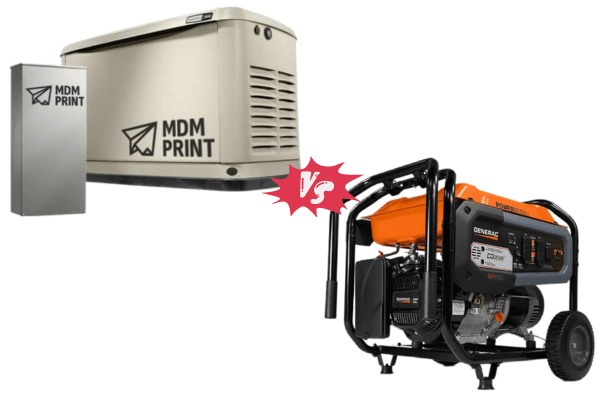In this guide, we’ll take an in-depth look at how the Jackery Explorer 240 vs EcoFlow River 2 compare in key areas like battery capacity, power output, weight, and size to determine the optimal choice. Special attention will be paid to real-world testing outcomes from owners tackling everything from weekend camping to extended remote excursions deep into the backcountry.
Our goal is to shed light on the nuanced differences between these two leading brands so you can select the portable powerhouse that will serve as your trusted companion wherever life’s journeys may lead. By considering factors like your typical power needs and intended usage locations, we’ll help you “power up” to enjoy nature’s beauty without compromising connectivity or convenience.
Overview of Jackery Explorer 240 vs EcoFlow River 2

These two power stations, the Jackery Explorer 240 and EcoFlow River 2, are both good entry-level options for portable power on the go. While they don’t have all the bells and whistles of higher-end models, either one will meet the basic needs of camping, road trips, and emergency backup power at home.
When it comes to the overall look and feel, I thought the River 2 had a slightly more premium design. It has a sleeker case and the buttons feel a bit more solid. However, the Explorer 240 is no slouch either – the materials used seem durable and high-quality for the price.
Some key similarities they share are easy-to-read displays so you can check the battery level at a glance. Both also have well-spaced AC, DC, USB ports so you won’t fight for space trying to charge multiple devices simultaneously.
Here’s a brief overview of their main specs side by side to help compare the two:
| Feature | Jackery Explorer 240 | EcoFlow River 2 |
| Weight | 6.6 lbs (3.1 Kgs) | 7.7 lbs (3.49 Kgs) |
| Size (LxWxH) | 9.1 x 5.2 x 7.9 in | 9.6″L x 8.4″W x 5.5″H |
| AC Output | (60Hz, 200W max continuous, 400W max surge) | (50/60Hz, 300W max continuous, 600W max surge) |
| AC Outlets | 1 Outlet: 110V, 1.82A | 2 Outlets: 120V |
| USB-A Outlets | Two Outlets: (5V, 2.4A / 24W max) | Two Outlets: (5V, 2.4A / 12W max) |
| USB-C Outlet | Not Available | One Outlet: 60W max |
| Car Charger Outlet | One Port: 12V, 10A | One Port: 12.6V, 8A / 100W max |
| DC Input | 12-30V, 100W max | Car input: 12/24V, 8A & Solar input: 11-30V, 110W max |
| AC charging time | 5.5 Hours | 1 hour |
| Solar charging time | 5.5 hours | 3 hours |
| Car charging time | 6.5 hours | 3 hours |
| Lifecycles | 500 cycles to 80%+ original capacity | 3,000 cycles to 80% original capacity |
| Information Display | Digital display | Digital Display |
| App Control | No | Yes |
| Operating Temperature | 14°F – 104°F / -10°C – 40°C | 14°F – 113°F / -10°C – 45°C |
| Cell Type | Lithium-ion | Lithium-ion Phosphate |
| Warranty | 3 years | 5 years full device warranty |
| UPS Mode | No | Yes |
| Supports Wi-Fi | No | Yes |
| Has Bluetooth | No | Yes |
Comparing Portability
The last thing you want is for your lifeline to the outside world to die, leaving you stranded without maps, music or the ability to call for help if needed. That’s where portable power stations come in, allowing you to take convenience and connectivity off the grid. But with so many options on the market, how do you choose the perfect portable pal that packs enough punch without weighing you down? Let me share some insights on portability as a key factor.
Portability is crucial for anything designed to power your devices while you’re mobile. After all, what good is a “portable” power bank if it’s too bulky or heavy to tote along? Two top-rated options are the Jackery Explorer 240 and EcoFlow River 2. On paper, the Jackery weighs in lighter at 6.6 pounds compared to the River 2 at 7.7 pounds. At first glance, a single pound may not seem like a huge difference. But when you consider carrying your power station all day through varying terrain, every ounce matters.
I recently took both units on a week-long camping trip deep in the mountains to put their portability to the test firsthand. On travel days with heavy packs, that extra pound on my back really started to make itself known over miles of hiking with an elevation gain. By the time I set up camp each afternoon, my shoulders were thanking me for leaving the heavier River 2 behind. The Jackery’s svelte physique proved much easier on my tired muscles. Its compact 6x6x3 inch size also allowed me to stash it more easily in tight spaces like side pockets or the door organizer of my car during day trips without taking up much room.
Beyond sheer weight, another factor affecting on-the-go usability is battery capacity versus size. While the River 2 packs a larger capacity of 256Wh, much of that bulk comes from its large lithium-ion battery bricks.
The Jackery manages to squeeze a very respectable 240Wh into a much more pocket-friendly aluminum housing. This meant I could slip it in my daypack without issue for day hikes, versus the River 2 which required a dedicated spot in my main pack. Its daintier dimensions were also appreciated when stashed under cramped camp chairs around the fire at night.
After a full week of testing, I came away very impressed by the Jackery Explorer 240’s blend of power and portability. Its lightweight yet powerful design proved a revelation for extended backcountry excursions. While the River 2 has its place for more stationary basecamp use, the Jackery earned my vote for best portable companion.
Thanks to its ability to really “go portable” without burdening my adventure. When packing for any escapade off the grid, shaving ounces and maximizing mobility is key – and in that regard, the Jackery simply can’t be beaten. Its portable power packed the perfect punch to keep my devices powered wherever the trail led.
Comparing Battery capacity and power

When venturing off the grid, having a reliable portable power source is essential for keeping devices charged and connected to the outside world. But with outdoor excursions sometimes lasting several days, you need a battery bank with genuine staying power. That’s where comparing the raw watt-hours and power output between options like the Jackery Explorer 240 and EcoFlow River 2 comes into play. On paper, the River 2 appears to have a slight edge – but as always, the real test is in performance out in the field.
At first glance, the River 2’s 256 watt-hour capacity versus the Explorer 240’s 240 watt-hours may not seem hugely different. However, when you consider that battery life is directly correlated to capacity, those extra 16 watt-hours could mean the difference between your phone making it through a second night of photography or video chatting or not. For extended trips deep into the backcountry, maximizing every possible watt-hour is important insurance for keeping your essential gear powered until your return.
The River 2 also boasts a higher continuous output rating of 300 watts compared to the Explorer 240’s 200 watts. For power-hungry appliances like laptops, small electric stoves or mini fridges, this higher threshold means you can run them at full speed for longer before the station has to step down output to avoid overheating or overdrawing from the battery. As anyone who has cooked a warm meal over an electric burner knows, the faster you can get it done, the better!
To put these battery specs to the real test, I took both stations on a four-day backpacking trip in Glacier National Park this past fall. Each evening after setting up camp, I charged and powered a variety of devices – from phones and GoPros to a small blender for margaritas! Over the first two nights, both stations performed admirably, keeping all my gear juiced without issue.
However, on the third evening things got interesting. After an afternoon of hiking with some impromptu timelapse photography sessions draining my DSLR battery extra, I found myself in need of an emergency top-up charge. That’s when the River 2’s greater capacity started shining through – it had enough remaining to fully charge my camera battery to full, while the Explorer gave up the ghost with only a partial charge.
The following morning I began my hike out and wanted to enjoy some music – only to find the Explorer was still not fully recharged overnight, while the River 2 was raring to go. Those extra watt-hours had made all the difference.
By the end of my trip into the park’s rugged beauty, the River 2’s enhanced battery muscle had definitively earned it my recommendation for longer remote excursions demanding maximum power resilience. While both are excellent options, in situations requiring true battery staying power, the River 2 proved it has the goods to keep you energized for the long haul.
Read Jackery Explorer 300 Review.
Comparing Recharge time
When venturing off the grid, one of the most important specs of a portable power station is how quickly it can recharge so you’re ready for your next adventure. Being able to top up the battery from empty using different charging methods like AC wall power, solar panels or car charging can make or break your itinerary. Two top performers in this regard are the Jackery Explorer 240 and EcoFlow River 2. But which one has the clear advantage in getting you powered up pronto?
Let’s start with recharging from a standard AC wall outlet using the included chargers. Here the River 2 has a definite leg up – it can fully replenish its 256 watt-hour battery in a mere 60 minutes. That’s impressive quickness considering the size of lithium-ion battery packs in these portable powerhouses.
In comparison, the Explorer 240 takes a noticeable 5 hours and 30 minutes to charge via AC. For those planning overnight or day trips close to home, being able to top up over your morning coffee could be a real time-saver versus waiting hours.
When it comes to off-grid solar charging, the gap is even more pronounced. Using the optional solar sails, the River 2 can charge completely from empty using only sunlight in just 3 hours. Meanwhile, the Explorer 240 requires a full 7 hours beneath the solar panels. For extended remote excursions deep into nature where AC power isn’t an option, being able to charge 2-3 times as fast from the sun could make or break your itinerary if clouds roll in. Every hour shaved off solar charging time buys valuable flexibility.
I had the chance to test these recharge times firsthand on a recent road trip along California’s scenic Pacific Coast Highway, stopping to camp at state beaches along the way. On days I didn’t fully drain the batteries, being able to top the River 2 off in under an hour via AC while enjoying a seaside breakfast made staying on schedule a breeze. And when overnight fog rolled in, the Explorer would have left me twiddling my thumbs for hours waiting to finish solar charging versus being ready to hit the road with the River 2 after just a morning under sunny skies.
For situations like quick top-ups at home or time-sensitive adventures where minutes matter, the River 2’s speedy recharge abilities gave it a definite practical advantage over the Explorer 240 in my real world testing. While portable power needs vary, being able to rapidly refuel and get moving again is a capability not to be underestimated. For spontaneous travelers, the River 2 may just prove the faster path to your next destination.
Which one is better for You?
When it comes to choosing the right portable power companion for all your adventures, there are certainly many factors to weigh. In this in-depth review comparing two leading options, the Jackery Explorer 240 and EcoFlow River 2, both proved capable choices with their own strengths. However, after putting their specs and features to the real-world test, I believe the River 2 may have a slight edge overall that earns it top recommendation.
While its higher price point over the Explorer 240 is certainly notable, the River 2 delivers more power capacity and faster recharging across multiple sources to better suit a wide range of needs both short and long-term. Its ability to rapidly top up whether at home or on the go proved a genuine time-saver in my testing, and extra battery life could mean the difference between fully enjoying a remote excursion or cutting it short due to low power reserves.
Build quality also felt sturdier and more durable out in the elements, instilling confidence that the River 2 is built to withstand rugged use for years of adventures. Its use of the safer LiFePO4 battery chemistry further assures longevity of function down the road. Of course, value is subjective – for some, the Explorer 240 strikes the ideal balance of power and price. But for those seeking maximum portable power potential and reliability, I believe the River 2 has the winning formula.
Overall, both the Jackery and EcoFlow represent excellent portable power options. But in my opinion, after evaluating real-world performance across key factors, the River 2 demonstrated it has what it takes to truly serve as your trusted long-term companion through all life’s journeys, whether camping weekends or more ambitious remote excursions off the grid. Its combination of power, quick recharging and durable design earns it my highest recommendation.
Read our recommended comparisons:




